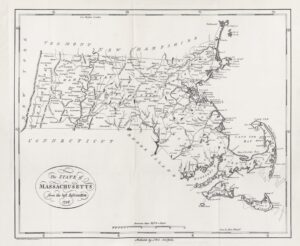 Click on image to expand it. Courtesy of the Perry-Castañeda Map Collection at the University of Texas
Click on image to expand it. Courtesy of the Perry-Castañeda Map Collection at the University of Texas
My maternal grandmother Sylvia was the youngest of seven children born to Rufus Herman Bailey of Windham, Rockingham County, New Hampshire and his wife Mina P. Watson of Boston, Massachusetts. Her Bailey lineage traces back to immigrant Richard Bailey, who died in Rowley, Essex County, Massachusetts, in 1647. My grandmother was a definite survivor. She lost her twin sister at eight months. She was hit by a car in 1920 at the age of 18. She lost her first daughter to scarlet fever when Shirley was just shy of her fourth birthday. Sylvia epitomized New England stoicism. She joined the Daughters of the American Revolution so that she could volunteer at the General John Stark house, which was just a block from her home in Manchester, New Hampshire.
It was her DAR application that I used to begin my journey into family history.
As I branched out from the Bailey direct line, I found many other early New England families: Chandler, Emerson, Farnham, Sheldon, and Webster, to name a few.
The more I researched, the more people I found, but none of the families traced had moved beyond Essex County. The towns of Andover, Bradford, Danvers, Haverhill, Ipswich, and Rowley were my stomping grounds – at least in books, as I was living in Florida when I began this research.
Even as I began to research my grandfather’s lineage, I was once again tracing old Massachusetts surnames of Ayer, Corliss, Merrill, and Webster. I discovered my grandparents were seventh cousins through the Websters. And I was once again researching the records of these same Essex County towns.
Despite still being part of the Great Migration – the British immigration to New England from 1620 to 1640 – it appeared that none of these lines would connect me to a Mayflower passenger.
If your early Massachusetts ancestors settled in the many towns of Essex County, then you too will not find a Mayflower line.
If your early Massachusetts ancestors settled in the many towns of Essex County, then you too will not find a Mayflower line. Essex County is located in the northeast corner of Massachusetts. Its northern border is New Hampshire and its eastern border is the Atlantic Ocean. It was part of the Massachusetts Bay Colony, a second English colony in what is now the state of Massachusetts. It was established by a royal charter from King Charles I on 4 March 1628/29, three years after the earliest settlers had arrived in what would be known as Salem.
The rest, as they say, is history.
My grandmother always wanted a Mayflower connection. She even hired a professional genealogist in the 1960s; it was not to be. As for me, I did eventually find a line that led me to a Mayflower passenger, but it was through my father’s ancestry by way of Illinois back through Ohio, New York, and Rhode Island to Massachusetts and William Brewster. And I’m pretty sure I heard my grandmother roll over in her grave when I made the final discovery. You see, she never liked my father.
Share this:
About Rhonda McClure
Rhonda R. McClure, Genealogist, is a nationally recognized professional genealogist and lecturer specializing in New England and celebrity research as well as computerized genealogy; is compiler of more than 120 celebrity family trees; has been a contributing editor for Heritage Quest Magazine, Biography magazine and was a contributor to The History Channel Magazine and American History Magazine. In addition to numerous articles, she is the author of ten books, including the award-winning The Complete Idiot's Guide to Online Genealogy, now in its second edition, Finding Your Famous and Infamous Ancestors, and Digitizing Your Family History.View all posts by Rhonda McClure →